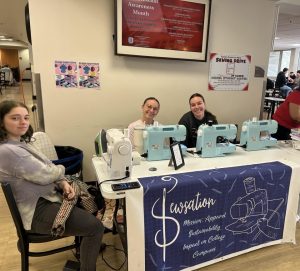*Editor’s note: Name has been changed to protect student’s identity.
One in four college-age women will be victims of sexual assault.
Only one in 10 of these will be reported, According to the Domestic Violence Resource Center,
“I was too scared to go through with a rape kit,” Sarah, a sophomore, said. “I just didn’t want proof that it had happened.”
Sarah had a few drinks with friends, went outside to go to a different friend’s house, and the next thing she remembered was waking up in the morning on the floor of her dorm.
“My friends told me that some kid from [a fraternity] brought me back to the dorm, and they found me in the hallway puking,” she said.
Sarah said her friends instantly knew there was something odd about her behavior.
“When I’ve blacked out before, I become really mean, started sobering up, then passed out,” she said. “But this time, I only started getting more mean, I had all the facts about my friends wrong, like their names and majors and I wasn’t responding.”
Sarah said her friends looked up her symptoms online and found they matched those associated with date rape drugs.
“I couldn’t tell them where I’d been or who I was with,” she said. “The next day my head hurt a lot, and I kept forgetting things all day long.”
Sarah’s story is not uncommon on college campuses, and though her friends pressured her to do so, she did not go to the hospital because she didn’t know what to expect there. She wanted to move on and forget it, she said.
The Bradley Sexual Assault Response Team, made up of staff and students from the health department, residential life, Help Empower and Teach students, the Center for Prevention of Abuse and more, knows sexual assault is often not reported and is revamping Bradley’s policy by next fall to create a consolidated location where victims can go for help.
“Looking at statistics, people don’t tell. Some of this is from embarrassment, and some of it is not wanting people to know,” said Barbara Carraway, the university’s Sexual Assault Response Team coordinator. “We want resources of who [victims] can tell, what they can expect when they report it and what it’s going to be like when they go to the hospital and have a rape kit done.”
Response
In many sexual assault cases, the victim has no idea they were even assaulted, Carraway said.
“They did a study at Auburn University. When they asked women if they had been assaulted, the women said no,” she said. “But when asked if they had been forced into sex without their consent, one in four of the students said yes.”
According to the Center for Prevention of Abuse, sexual assault is “any sexual contact that is unwanted or not agreed to.” It can happen in situations like date rape, domestic or intimate partner violation, or by a stranger, and all forms of sexual assault are crimes.
Carraway said regardless of the campus, the stigma remains that students are wary of reporting assault.
“A lot of people just know something was wrong,” she said. “It’s difficult on a college campus because you’re going to run into people. And it’s not just women. It happens to men, too.”
Junior HEAT Sexual Assault Chairperson Chelsey Rolando said victims might be wary of coming forward because they feel like they brought the assault upon themselves.
“The big question [HEAT] focuses on is ‘Is consent given, and was it able to be given?’ ” she said. “A lot of people don’t consider a lot of things sexual assault. A lot of them think ‘I drank too much, I deserved this,’ or ‘I flirted too much, I deserved this.’ ”
Particularly on a Bradley-sized campus, victims worry about news of the assault spreading, Ronaldo said.
“A lot of people on campus are afraid other people on campus will find out, and people might not want to mix it with where they live,” she said. “Some people instead report it to the Center for Prevention of Abuse. It’s definitely a goal to get people to report.”
After reporting, students are strongly advised to get a rape kit, Dr. Jessica Higgs, director of Health Services, said.
“If someone is concerned they have been sexually assaulted they should go to the emergency room within 72 hours of the assault,” she said. “They should not shower or wash the clothes that they were wearing.”
A collected rape kit does not force the victim to press charges, Higgs said.
“It just makes the information available should they want to take action in the future,” she said.
Even if it has been more than 72 hours since the assault, victims should still seek medical attention, Higgs said.
“They should be tested for sexually transmitted infections and look into services available to them, including counseling.”
Higgs said signs to determine if someone has been slipped a date rape drug are a person appearing far more intoxicated than they should be, difficulty standing and lacking focus on their conversations.
“No one should lose track of their drinks or accept drinks from strangers without watching the bartender pour the drink,” she said. “You should always have a buddy that you are out with.”
Higgs said signs of sexual assault include a significant amount of time unaccounted for, or soreness or bruising that cannot be accounted for.
Policy Revisions
“What we’ve found is that before computers, we used mostly print and had brochures,” Carraway said. “Now we are trying to get it succinctly in one place. The sexual assault policy goes back 20, 30 years ago, and I don’t think it’s changed much.”
Director of Residential Living Nathan Thomas said the Sexual Assault Response Team wanted to create a more up-to-date, user-friendly site for victims to seek out resources.
“Right now, the system in place is not user-friendly,” he said. “If someone is a victim or wants information on sexual assault, we want them to have everything in one existing spot.”
The new site is also aimed at friends of victims or just students seeking out information, Thomas said.
“I would say we often hear from friends before we hear from victims, and encourage those people to talk to someone,” he said. “It makes us aware and also provides the student with information. They don’t have to give us names, or they can. They have that option.”
Ronaldo said it’s important for the new policy to be clear so more victims will feel they have the knowledge and the tools to report assaults.
“In designing the website for the policy, we wanted in depth information, but we also wanted it to be easy to read,” she said. “We’re trying to cater to people.”
Ronaldo said the one thing to emphasize is that the victim should never feel like they have to keep quiet out of shame.
“Stay with people you trust and use your voice,” she said. “Know what you want.”
Reporting Process
For victims who choose to report a sexual assault incident to the police, there are varying options ranging from filing an anonymous report to pressing charges.
“The closer to the incident they report it, the better it will be to collect evidence, especially involving date-rape drugs,” Lt. Troy Eeten said. “[If a student chooses to press charges], we’ll do an investigation and the state’s attorney reviews it to see if there’s enough to prosecute, if that’s what the victim wants.”
If a student calls the police to report that they have been sexually assaulted, the first step is medical attention, Sgt. Rick Hutchison said.
“We try to convince the victim to go to the hospital,” he said. “Counselors are provided anytime somebody goes to the hospital for sexual assault. We work together with the [Peoria police] and take whatever information we can. The biggest thing then is what happens next.”
Hutchison said if the victim does not want to tell the police, they should make sure to tell someone they trust.
“Down the road, if they want to prove it, it’ll be good to have someone who heard it from the victim’s own words,” he said. “That helps avoid a ‘he said, she said’ situation.”
Victims should not be deterred from reporting even if they had been drinking illegally or using drugs, Eeten said.
“You’re looking at self-preservation, so don’t let that keep you from reporting it,” he said. “We do not victimize the victim if this happens while they’ve been drinking. I’ve never known of charges being placed on a victim for drugs or alcohol.”
Eeten said even if someone came in to make the police aware of something, it would have to be reported.
“The numbers have remained consistent,” he said. “The stats over the years have been that we get three to six reports of sexual assault throughout the year.”
According to statistics from the U.S. Department of Education, the total on-campus sexual assault reports for Bradley in 2009 was two, and five in 2008 and 2007. These numbers haven’t varied much throughout the years, Eeten said, and Bradley’s average reports are in line with other mid-size, private universities.
“The majority of these happen in the dorms or in fraternities or sororities, and from acquaintances” he said. “The biggest prevention is education.”




